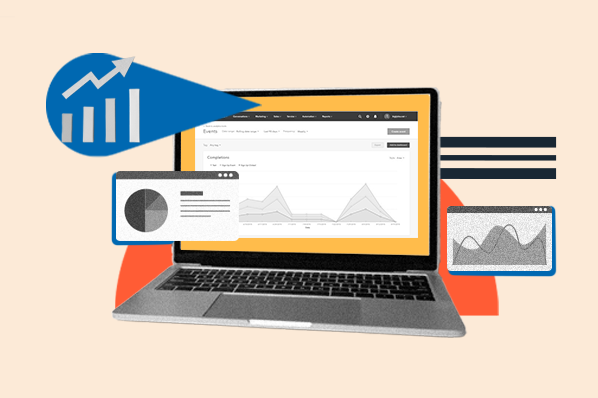Table of Contents
- Ecommerce Website Performance
- Ecommerce Website Performance Metrics
- How to Improve Ecommerce Website Performance
- Website Performance Trends
- What’s next for websites?
Ecommerce Website Performance
When I create a new ecommerce website, I’m always most excited about the content. What are the products I’ll sell? What photos and copy will I use to market those products? As a business owner with a marketing background, I’ve always been drawn to this part of the website development process.
However, over the course of my career, I’ve learned that the content is only step one. To create an ecommerce website that makes a real impact, it’s essential to proactively and regularly measure its performance.
After all, if you don’t have a way to assess your performance, how can you know if you’re succeeding in achieving your goals? And how can you know what steps you can take to improve?
These are difficult questions, and they don’t have easy answers. When it comes to tracking ecommerce website performance, there are no one-size-fits-all solutions. Different businesses will have different priorities, and as such, it’s important to identify the ecommerce website performance metrics that are most relevant in your unique context.
That’s why I decided to put together this list of my favorite ecommerce website performance metrics. You can use a few of the metrics below, use all of them, or even just use this list as inspiration as you develop your own performance metrics strategy.
Pro tip: If you’re looking for an easy way to get started, HubSpot’s free CMS offers powerful website analytic tracking to help you make smarter, data-driven decisions.
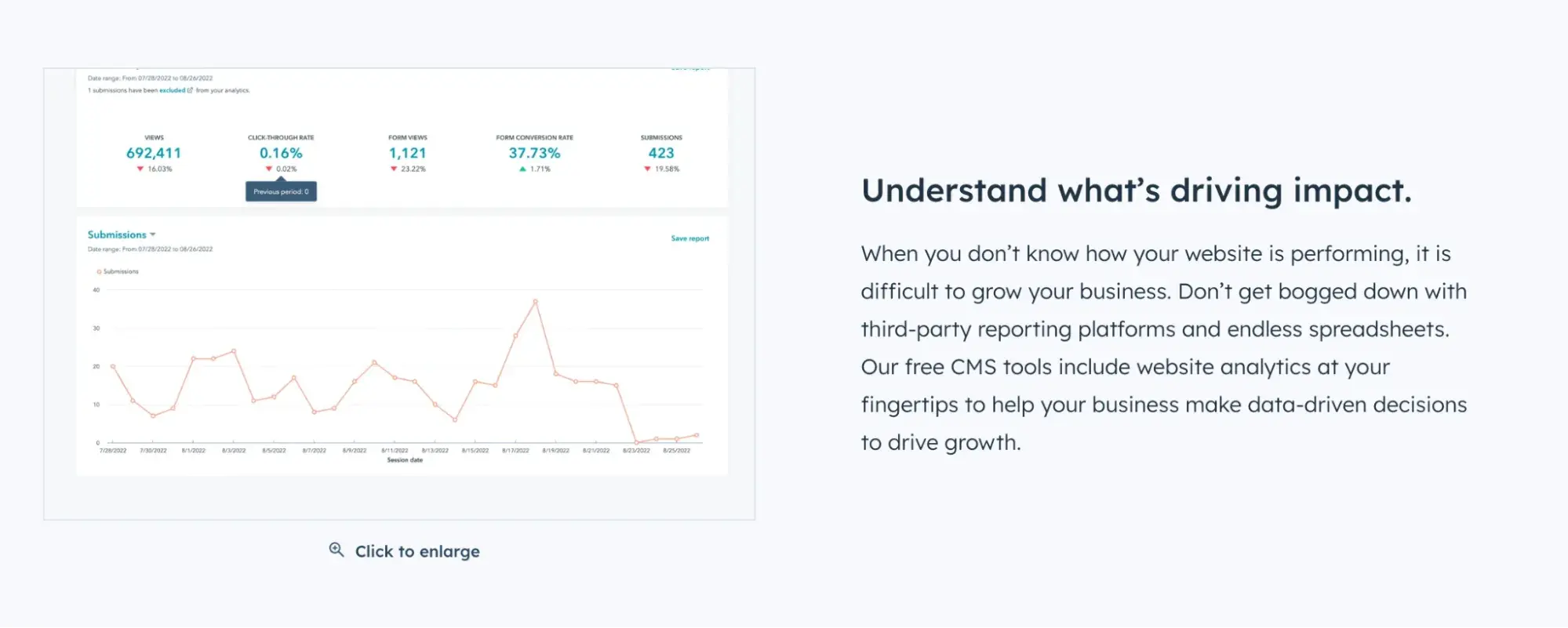
Ecommerce Website Performance Metrics
1. Total Number of Visits
The first metric that I always recommend tracking is the total number of people visiting your website. This can be measured weekly, monthly, quarterly, or even annually, and it gives you a general sense of the traffic that your ecommerce website is getting.
In my experience, measuring the total number of website visits is a great way to get a quick understanding of the health of your website and audience. If the total number of visits goes down, that may mean that it’s time to launch a new marketing initiative, and if it goes up, that may mean that your recent ad campaign or product launch was a hit.
Importantly, it’s generally best to measure your website against its own past performance. Rather than getting caught up comparing yourself to a massively popular competitor, or worse still, to a business in an entirely different market or industry, I always recommend focusing on your own growth.
2. Total Unique Visitors
In addition to tracking the total number of visits to your website, it’s also critical to track total unique visitors.
What does this mean? Sometimes, the same user will visit your website multiple times. For example, they may get distracted and then come back to it later, or they may be interested in checking on recent updates. Whatever the reason, this means that the total number of visits to your website may be larger than the number of unique visitors.
As marketing expert and Netpeak Journal editor Natalia Koshel explains, “A unique visitor is a person who has visited the website at least once and is counted only once in the reporting period. This metric allows you to determine the number of people who viewed the website, regardless of how many times each person visited the site.”
In addition, beyond just knowing how many unique users are visiting your website, tracking total unique visitors also enables you to determine the average number of visits a unique user makes.
For example, if your website received 150 total visits and 100 unique visitors in the last week, that would mean that your average visits per unique visitor would be 1.5. Calculating the average number of visits per unique visitor can give you important visibility into how your audience is engaging with your website, which you can use to inform your strategy going forward.
3. Largest Contentful Paint
Largest Contentful Paint, or LCP, is a measure of how long it takes the largest piece of visible content (whether that’s an image, a video, or a block of text) to render fully on a user’s screen.
This may seem fairly technical, but it is especially important to improve LCP because this is one of the core metrics that search engines like Google use to evaluate the performance of your website. As such, if you want your site to come up at the top of the SERP (Search Engine Results Page), it’s vital to determine how to improve LCP.
Furthermore, “LCP is important for website performance because users expect fast-loading websites,” writes content marketing consultant Boris Mustapic. As Mustapic explains, “Improving LCP can make the site feel faster and ready for interaction sooner.”
4. Average Session Duration
Another one of my favorite ecommerce website performance metrics is average session duration. This metric focuses on the average amount of time that visitors spend on your website in a single session.
Why is this important? Content marketing expert Stefana Zaric offers a helpful analogy: “Imagine you’re in a store, shopping. The longer you stay, the more likely you are to buy (more), right?”
Zaric continues, “It’s similar with your website. The longer users stay on your pages, the more pages they read, and the deeper they scroll on each page, the bigger your chances are of converting them. So, you need to know how much time users spend on your website, as well as what actions they take while they are there.”
Tracking average session duration is an important way to get a sense for not just how many people are visiting your website, but how engaged they are — which is critical if you want to turn website views into closed deals.
5. Pages Per Session
Pages Per Session is another great way to get a sense for your users’ level of engagement. This metric measures the average number of different pages visitors view on your website during a single session.
According to a recent report based on data from nearly 500 companies, visitors to the average B2B company website view a median of 1.89 pages per session. That suggests that if your website has an average of two or more pages per session, you’re doing great … but if you’ve got fewer than two pages per session, it may be worth exploring ways to improve your content strategy and website design.
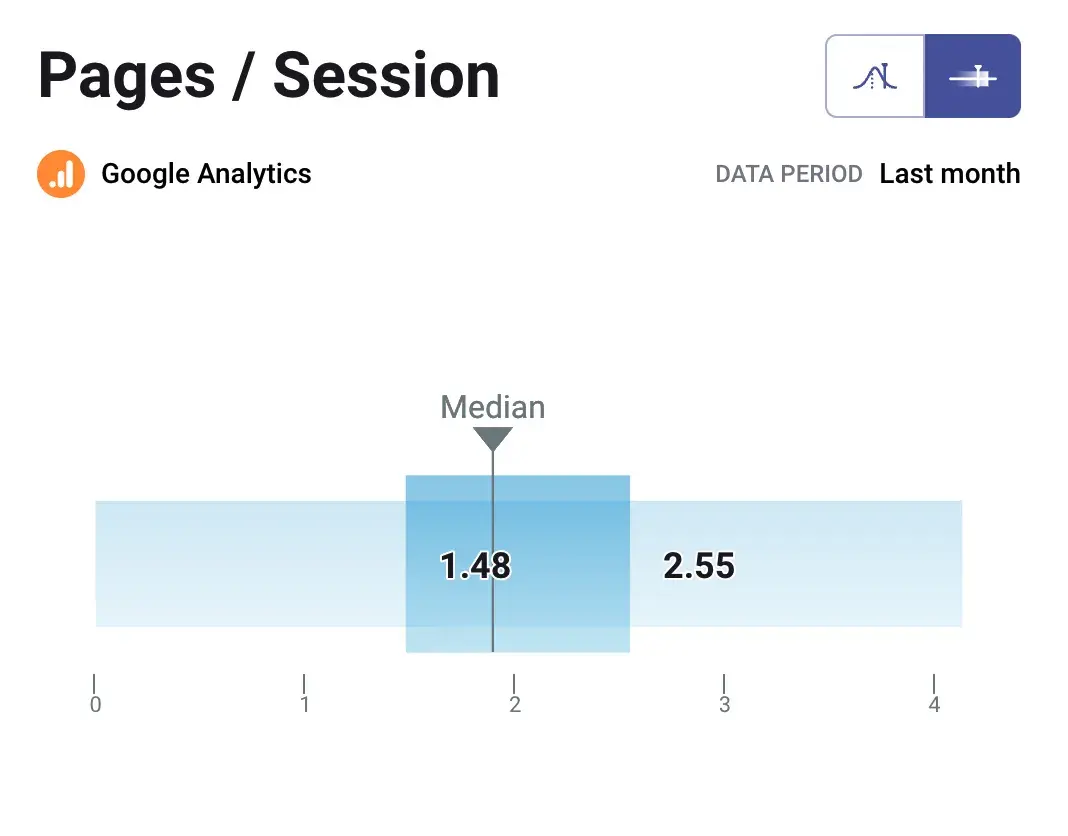
6. Bounce Rate
If you’re anything like me, you love to focus on how much time people are spending on your website — but it’s equally important to pay attention to how often they’re leaving it. Bounce rate refers to the number of times someone visited your website for under 10 seconds, didn’t convert, and viewed fewer than two pages.
In general, bounce rate is reported as a percentage of all visitor sessions, giving you a sense of how often people visit your website and immediately leave. And importantly, some amount of bouncing is to be expected: Across industries, the average bounce rate is 44.82%. But if yours is substantially higher than that, it could be a sign that you’ve got a user engagement problem.
7. Conversion Rate
At the end of the day, the purpose of an ecommerce website is to sell a product. As such, no list of ecommerce website performance metrics would be complete without a mention of conversion rate.
Conversion rate is the percentage of website visitors who ultimately convert into customers. To calculate your website’s conversion rate, just divide the number of users who convert by the total number of visitors. For example, if 100 users visit your website and five buy a product, your conversion rate is 5%.
E-commerce strategy expert and SEO Lead at Shopify V Vineet Kumar argues that “as a store owner, your ecommerce conversion rate might be the ultimate indicator of your business’s viability.” While there are many important metrics to track, Kumar suggests that “a great ecommerce conversion rate is crucial to your store’s success.”
8. Cost Per Acquisition
Alongside conversion rate, I’ve found that it’s also critical to measure cost per acquisition. After all, if it costs $100 to bring in a $10 customer, that’s hardly a recipe for business success.
Cost per acquisition is a metric of how much it costs a company to convince a website visitor to convert into a customer. In general, this is calculated by dividing the total cost of a given campaign by the number of users who end up converting.

Mina Elias, founder and CEO of marketing agency Trivium Group, suggests that cost per acquisition “is an important metric to keep track of, not just because it allows you a more granular approach to analysis but by knowing your cost to drive a sale you can determine how much more you can expend to drive the growth of your brand.”
Monitoring how much it costs you, on average, to convert website visitors into customers is vital to help you optimize your marketing and sales strategies.
9. Organic Traffic
Organic traffic refers to the total number of visitors who come to your site organically — that is, who arrive via unpaid and unpromoted search results, rather than by clicking on a paid ad. I love using this metric to get a sense of how much free traffic my ecommerce website is attracting just by offering insightful, relevant content to my target audience.
In my experience, it’s important to distinguish between visitors who come from paid ads and visitors who find your website organically. Otherwise, you’ll have no way to determine how much it costs you to get those users to your website and no sense of how well your content is naturally resonating with your customer base.
As ecommerce and SEO consultant Sarah Smith explains, “Organic traffic is one of the most important metrics for any e-commerce store.” She continues, “Unlike paid traffic, which comes from ads or sponsored posts, organic traffic is free and indicates that your website is relevant and trustworthy for your target audience.”
10. Page Load Speed
Finally, the last vital metric that I always make sure to consider is page load speed. This is a measure of how many seconds it takes to display your entire webpage on the average user’s browser.
Of course, page load speeds vary substantially depending on the user’s network speed, which is outside of your control. However, the decisions you make when designing your website can influence the page load speed as well, so it’s important to consider this metric when exploring opportunities to optimize your online presence.
According to data from Google, web users are 32% more likely to bounce if a page takes three seconds to load than if it takes one second. A faster page load speed dramatically improves the user experience, and so I definitely recommend prioritizing keeping your website as speedy as possible.
How to Improve Ecommerce Website Performance
Once you’ve determined the metrics that are most relevant for your business, it’s time to start making improvements. Here are some of my top expert-approved strategies to help you improve your ecommerce website performance:
1. Don’t sleep on SEO.
When it comes to driving traffic to your website, Search Engine Optimization (SEO) is one of the most important tools in any marketer’s toolbox.
By ensuring that your content is designed to perform well with both human users and search engines, you’ll be on your way to improving the performance of your ecommerce website.
Indeed, as Senior Director for Sales and Marketing at Kingstar Media Geoff Crain points out, “Creating and maintaining a strong SEO strategy can help ensure that a brand is being seen by the right audiences, and it’s a cost-effective method to drive traffic, leads, and sales.”
If you’re not sure where to start, I’m a big fan of HubSpot’s Content Marketing Software, which offers a range of services to help you develop SEO-optimized content. In addition, I’d recommend conducting a comprehensive audit of your content to ensure you’re following SEO best practices, such as listing alt text for images, including key metadata tags, and strategically leveraging keywords throughout your website.

2. Prioritize personalization.
Once you get a user to visit your website, how can you convince them to stay and engage? When it comes to delighting website viewers, I’ve learned that personalization is key.
Of course, effective personalization will look different for different ecommerce businesses. In some cases, it may make sense to use people’s purchasing and browsing histories to strategically highlight new products that may be particularly appealing to them. In others, there may be opportunities to notify customers about abandoned carts or upsell them new versions of products they’ve already bought.
Ecommerce and SEO specialist Leigh-Anne Truitt notes that in today’s ecommerce ecosystem, providing a personalized experience is table stakes.
She reflects, “Today’s customer expects personalized shopping recommendations from ecommerce sites … a personalized shopping experience can lead to additional purchases, but it can also increase a customer’s lifetime value and customer engagement.”
Ultimately, Truitt argues, “Customers satisfied with their experience at your store means there’s a higher chance they’ll return.”
3. Improve LCP.
The content your users see is one piece of the equation — but the technical foundation of your website is just as important. In particular, I believe that improving your website’s LCP, or Largest Contentful Paint, is a critical strategy to improve your overall ecommerce website performance.
As with many performance metrics, there are no shortcuts or one-and-done solutions to boosting your LCP. Former Technical SEO for IBM Patrick Stox speaks eloquently to this challenge, noting that “there are a lot of issues that relate to LCP, making it the hardest metric to improve.”
He clarifies, “The general theory sounds easy enough. Give me the largest element faster. But in practice, this can get fairly complex. Some files may require others to be loaded first, or there may be conflicting priorities in the browser. You may fix a bunch of issues without actually seeing an improvement, which can be frustrating.”
Nevertheless, Stox offers some helpful advice: “If you’re not very technical and don’t want to hire someone, look for performance or page speed optimization plugins, modules, or packages for whatever system you’re using.”
You can also look to tools like HubSpot’s Ultimate Website Optimization Checklist to help make sure you’ve dotted your i’s and crossed your t’s.
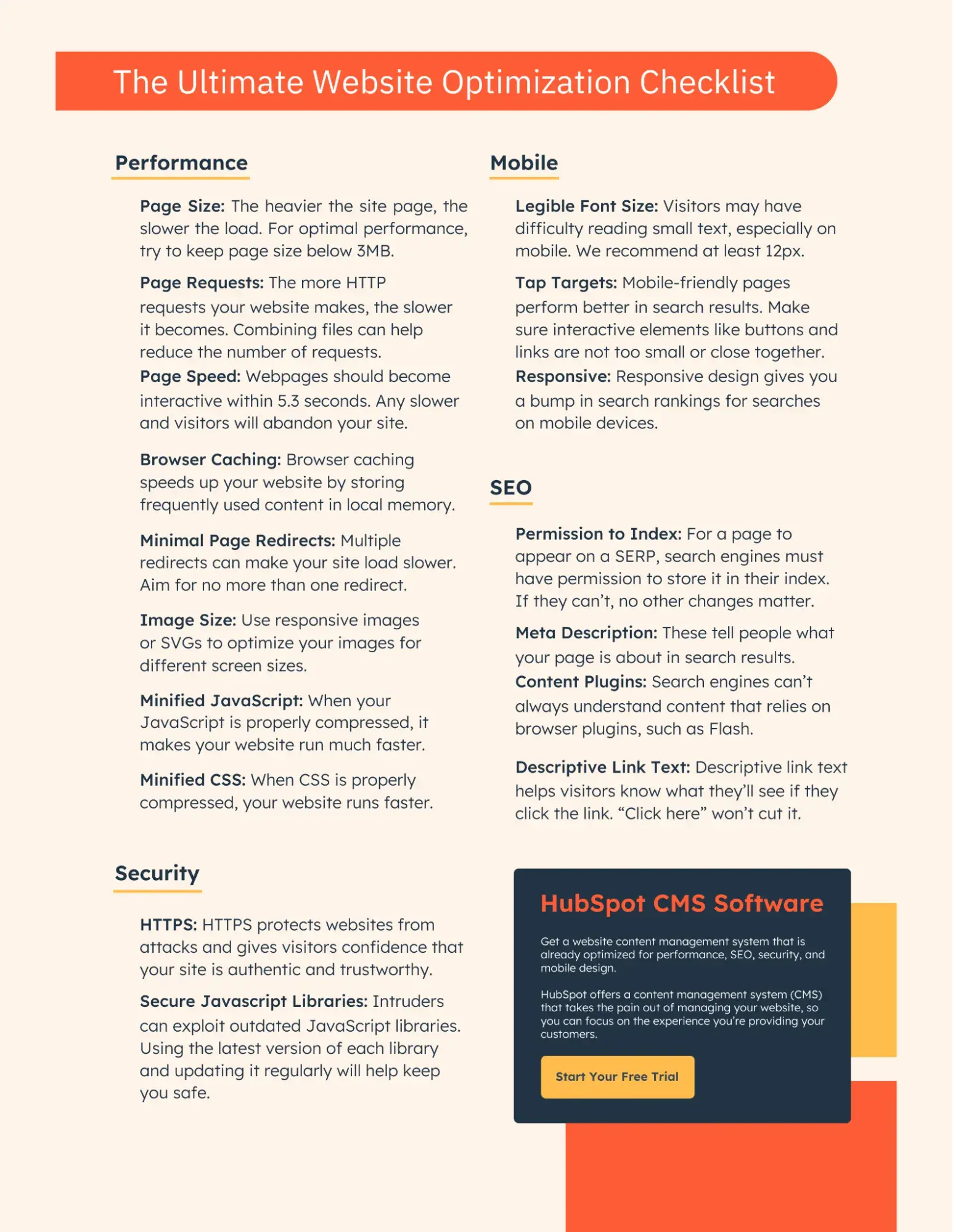
At the end of the day, improving LCP isn’t easy. But in my experience, it’s a vital piece of the website performance optimization puzzle — so it’s definitely worth spending the time to get it right.
Website Performance Trends
When it comes to developing the best possible ecommerce website, it’s important to remember that we don’t operate in a vacuum. While reviewing the metrics and improvement strategies I’ve shared so far is an important start, it’s also essential to stay up to date on the latest website performance trends.
To that end, I’ve compiled some of my favorite data-driven website performance trends below:
1. Images and videos boost engagement.
When it comes to online content, a picture is truly worth a thousand words. If you want to engage your visitors and keep them scrolling, research shows that including lots of imagery and video on your website is key. In fact, recent data suggests that 99.9% of websites today have images.
As such, while the written copy on your website is important too, I’ve learned that it pays off to invest in quality image and video content as well.
Why are visuals so powerful? Sam Hollingsworth, SEO Manager for the marketing agency 829 Studios, argues it’s because “humans are visual-oriented beings.”
Hollingsworth explains, “Vision is responsible for 80% of everything humans learn, and similar numbers are likely for most animals with developed brains. That’s why visual-rich media, like photos, images, and videos, have a huge impact on the success of written content and overarching content marketing strategies.”
To capture your audience’s attention — and to maximize the chances that your ecommerce website visitors will convert into paying customers — it’s critical to prioritize the quality of your image and video content.
2. Today’s users are less patient than ever.
Of course, part of the challenge of including lots of high-definition images and videos on your website is that these kinds of files are large … which can seriously slow down your website’s load time. And while today’s users expect excellent visual content, they also expect the web pages they visit to load quickly and seamlessly.
Indeed, while internet users in the past may have been willing to put up with slow, clunky experiences, today’s users are less patient than ever. According to one recent report, 25% of visitors will leave a website if it takes more than four seconds to load, and 70% of consumers report that page load speed influences their online purchasing decisions.
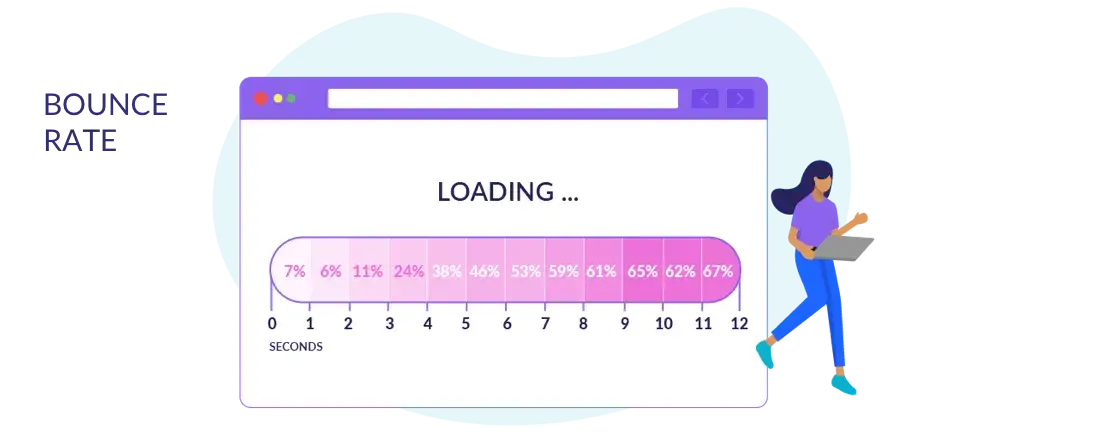
That’s why website optimization expert Emma Ryan believes that “load times can make or break your website.” As she describes, “If your homepage takes too long to load, visitors are much more likely to exit the page and miss out on your fantastic content — a key reason why you shouldn’t overlook load times when building a website.”
As a result, to maximize the performance of your ecommerce website, it’s critical to take steps to improve LCP and ensure your page load speed on both mobile and desktop is as fast as possible.
For example, a system like HubSpot’s CMS Hub Platform and Hosting offers access to a range of tools to help you optimize your website performance and ensure your users get the speedy experience they expect.
3. Mobile-first is a must.
Another clear trend in 2025 is that being mobile-first is a must.
Today, 70% of all internet traffic comes from mobile devices such as smartphones or tablets. To succeed in this new digital ecosystem, web developers need to create ecommerce websites that are built for mobile, rather than simply trying to adapt desktop-first websites for a mobile experience.
As Jeff Blanchard, Design Director for digital innovation firm Highland Solutions, explains, a mobile-first website “is built for mobile devices first and then made to work for desktops, tablets, and laptops, rather than the other way around. The mobile device user is the priority.”
Importantly, that doesn’t just mean creating a mobile-friendly experience. Even if a website technically works on mobile, your users will be able to tell if it was built primarily for use on a desktop computer. To provide the best possible experience (and to drive the best possible performance), mobile-first web development is a must.
4. AI is here to stay.
Finally, I have seen firsthand just how much of an impact AI is having on the world of ecommerce businesses.
On the one hand, automated systems are helping businesses optimize their website performance, with AI tools offering everything from user behavior prediction to real-time personalization of on-page content. At the same time, all this AI-powered content can create major load delays, extending page load times and thus unintentionally worsening the user experience.
In light of these conflicting trends, I’ve learned that web developers must embrace the power of AI while ensuring they take steps to address the challenges it can introduce. Indeed, as content marketing expert Isabelle Hahn explains, “Artificial Intelligence is the future of ecommerce.”
Specifically, Hahn notes that “today, sellers can generate product descriptions using generative AI and rely on GPT4-enabled customer service. Soon, teams can create paid ad creative and launch marketing campaigns personalized to each buyer.”
She continues, “Not only does AI make online shopping easier for the consumer, but it also helps ecommerce sellers and companies grow their businesses through everything from operations to creativity.”
This is borne out by the data: A recent survey found that one in three American B2B ecommerce businesses have fully implemented some form of AI, 47% are evaluating AI technology, and just 3% report having no intention of using AI.
In other words, AI is here to stay. To stay competitive, today’s ecommerce businesses must embrace it — or risk falling behind the competition.
What’s next for websites?
The world of ecommerce website performance is complex. There are countless metrics you need to keep track of, numerous strategies that can help you improve your performance, and ever-changing trends to stay on top of. So, as I look to the future, I can’t help but wonder: What’s next for ecommerce websites?
As I wrote this article, I was struck by one simple fact: Despite all the complexity surrounding website performance, at the end of the day, building an effective ecommerce website is all about engagement. If you focus on tracking metrics that reflect engagement — and if you take steps to improve those metrics and turn that engagement into conversions — you’ll be on your way to creating a successful ecommerce website.
Editor's note: This post was originally published in February 2023 and has been updated for comprehensiveness.
Web Analytics


.png)

![10 Best Tools to Check Website Traffic [+ What They’re Best For]](https://53.fs1.hubspotusercontent-na1.net/hubfs/53/GettyImages-1332148900%20copy.jpg)





